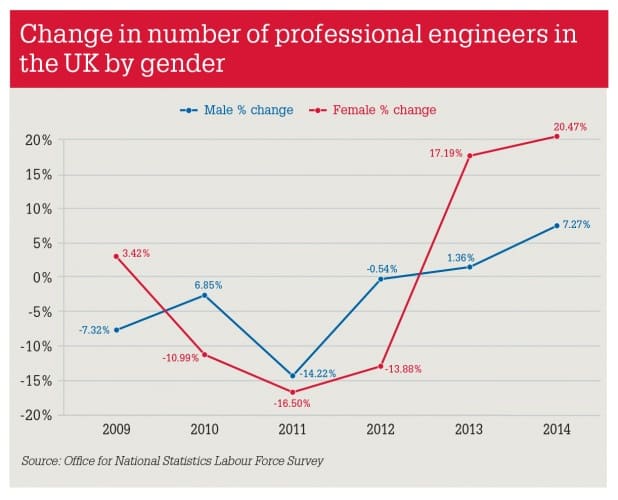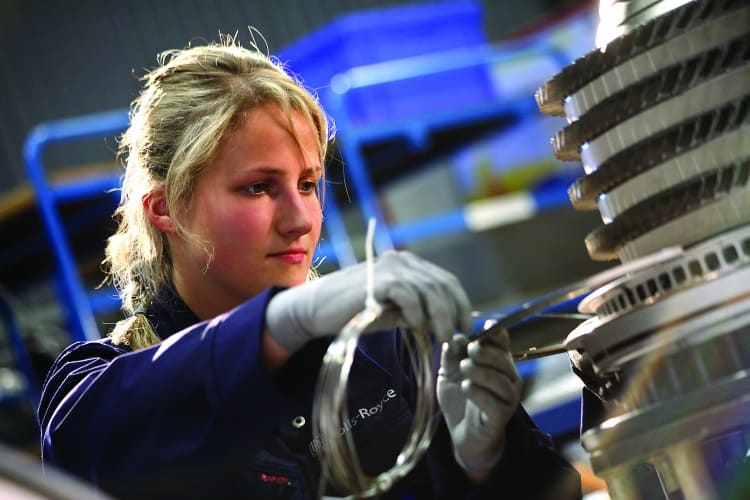
If you’re lucky enough to see an engineer on television these days there’s a good chance they’ll be a woman. Large engineering firms have done a good job of unearthing the female talent from within their ranks and putting these women forward to represent their employers – and the profession as a whole – as modern and inclusive as well as technically advanced.
From schools initiatives to recruitment brochures full of female faces, the industry is going out of its way to appeal to women as a way of tackling the looming skills shortage. And there are signs that it’s beginning to work. In the last 10 years there’s been a 20% increase in the number of women receiving undergraduate engineering degrees each year – a slightly higher rise than for the subject overall. And, according to the most recent data available from EngineeringUK, the proportion of female graduates who went to work for engineering firms grew from 50.0% in 2010/11
to 57.7% in 2011/12 (though this may be partly explained by the economic recovery).
Yet the overall proportion of working engineers in the UK who are female hovers stubbornly around six per cent. Figures from the Office for National Statistics actually show there has been a significant increase in the number of female engineers in the last couple of years. But a much greater number of women left the profession – and at much higher rates than men – when the economy flatlined at the start of the decade. In short, engineering has lost more women than it has gained. Things may have started to change at the entry level, but the industry still has a lot of work to do to ensure it holds on to all its talent.
Just how many women have given up on engineering altogether even as the job market has improved is very difficult to determine. Recent research looking at barriers to women returning to careers in science, technology, engineering and maths (STEM) was only able to contact around 300 women who had left the field altogether, out of a total of over 5,000 respondents.
But you don’t have to look far to find stories of the extra challenge of being a woman in engineering. ‘You have to work harder to prove yourself, you have to challenge more to get decent work and you have to bite your tongue and ignore a lot of patronisation and sexism,’ said one woman in response to a recent request on The Engineer’s website for personal stories from female engineers.
Unfortunately, sexism in the workplace is still common in many industries and it’s not hard to imagine such comments coming from women in finance, law or architecture. The research into barriers to re-entering STEM, carried out by the Women’s Engineering Society and Women in Manufacturing, found that 60 per cent of respondents thought there were obstacles to returning to work after a maternity break. But the biggest barrier was the cost of childcare – a universal problem for parents.

So does engineering have a particular problem with the way it treats its female employees? Part of the issue may be to do with ongoing stereotypes that women are less interested in technology, less capable at maths, and less able to cope with anything physical. But Sue Ferns, head of research at the professionals’ union Prospect, which collaborated on the survey on re-entering STEM, believes problems are exacerbated by the very fact that women engineers represent such a small minority. ‘Engineering is a male-dominated industry, so problems are more acute because it’s not the cultural norm [to address them].’
’On The Engineer website, we heard from women who had been passed over for jobs because of their gender, bullied by co-workers, and laughed at for suggesting they shouldn’t have to work with heavy machinery while pregnant
On The Engineer website, we heard from women who had been passed over for jobs because of their gender, bullied by co-workers, and laughed at for suggesting they shouldn’t have to work with heavy machinery while pregnant. Some complained about being singled out for being women and treated as if they couldn’t cope with colourful humour or language, while others noted that the run-down state of some engineering facilities and offices may be more likely to put off women than men (a comment that itself plays into stereotypes about both women and the nature of engineering today).
What’s more, the industry is now made up of huge proportion of small and medium enterprises [SMEs] where women engineers have rarely or never been employed, which creates particular challenges when issues like flexible working to accommodate childcare are raised. ‘It’s not that companies are opposed to it but with fewer women employed they are less likely to have been asked, they are less likely to have thought about it,’ says Ferns.
It is, of course, virtually impossible to find a company that will admit to having a problem with chauvinistic behaviour. However, while a firm’s chief executive may be publicly committed to ensuring an equal workplace, that attitude has to filter down to every level of the company to have an impact. ‘There’s a persistent gap between companies coming up with great policies and delivering them,’ says Ferns. ‘It becomes a lottery of who your line manager is.’
Addressing this requires management to make sure positive attitudes are visible across the business, says Linda Emery, global head of talent attraction at BP, where women fill around one fifth of both STEM and senior roles – far higher than the industry average. ‘The first thing is to have a clear commitment from leaders about why this is important.’ At larger firms it may be easier for human resources teams to enforce anti-discrimination and sexism policies, but male-dominated workplaces can create additional problems that individual managers need to look out for. ‘We’ve gone well beyond the days when there were no female toilets or where [women] couldn’t talk about what was important to them because only football mattered – I think it’s more subtle now,’ says Emery.
’‘There’s a persistent gap between companies coming up with great policies and delivering them
Sue Ferns, Prospect
One of these subtle manifestations of sexism is unconscious bias, the way we automatically make judgements about people without rationally considering them as individuals. ‘A line manager might make an assumption that someone isn’t interested in an overseas move, for example, without actually going and asking them,’ says Emery. ‘We’ve been running training for all our leaders in unconscious bias. It’s very important for all of us to recognise what our biases might be and address them.’
Jane Wernick today runs a successful consultancy practice but in the 1990s left a job with a major firm because she saw her male colleagues promoted above her with no sign that she would progress as well. ‘I think it’s a cultural thing and people tend to promote people that are like themselves,’ she says. ‘When my own mentor died I was left without a supporter at a high level, and both men and women need support from higher levels. Some women are perhaps able to act in ways which are subtly more like males – I’m probably not one of them.’
Emery agrees that making sure women in senior roles are visible to the rest of the company is crucial for busting stereotypes and addressing unconscious biases – including any beliefs women themselves might hold that they can’t progress. ‘Having female role models in leadership positions is hugely important,’ says Emery. ‘There are a lot of perceptions in across the industry, and this isn’t unique to oil and gas, that women can’t succeed. Actually we have a lot of very successful women in BP and we’ve had to encourage them to be very open about that. A lot of people who are successful don’t want to shout about it, they want to get on and do their job. But actually it’s really important for more junior women coming through the organisation to be able to see people that they can relate to.’

Sharing inspiring stories and making sure women have the right support can be easier if a company has a women’s professional network. Engineering consultancy Atkins has hundreds of offices around the world and provides a toolkit to enable even its smaller departments where there may be only a handful of female employees to create their own women’s networks. ‘We encourage them to try to get involved in larger events so that they don’t feel completely isolated,’ says the firm’s recruitment manager Victoria Jones. ‘The virtual community is a really good one if you can get the momentum behind that with knowledge exchange, sharing ideas, making sure people know when and where networks are.’ There are clear lessons here for smaller firms that might not be able to form their own women’s network but could help encourage female staff to join a wider community.
Other important issues that engineering employers can address to try to retain female staff are maternity leave and flexible working after a women has children. Rolls-Royce says its female employees on average aren’t more likely to leave the company than its male ones but that there are ‘pinch points’ in the career cycle where they see more women resigning or accepting voluntary redundancy. To help make returning after childbirth easier, the company offers a range of training and mentoring before, during and after the maternity leave period, as well as helping to find appropriate childcare and paying for two free emergency childcare sessions a year. ‘We also have done a lot of work with line managers and human-resources colleagues to let them know what good practice looks like in terms of managing someone on maternity leave and returning,’ says Eleanor Radbourne, Rolls-Royce director of core capability in engineering and operations.

Like many companies, Rolls-Royce also offers a range of flexible working options that are made easier by the internet and communications technology. ‘The changes in the way that we work [mean] the need to be together in the same room to solve problems and have discussions just is not the same as it was,’ says Radbourne. ‘We’re all over the world, not just in the UK, so most teams have people that don’t sit in the same location anyway now. We’ve been forced to think differently about the way we interact and communicate with people.’
’Men as well as women are increasingly likely to be put-off by old-fashioned or sexist attitudes (or even run-down facilities)
Equally, however, Radbourne admits that arranging flexible working can be a difficult task, especially when you’re dealing with a small team on tight deadlines. Although discriminating by gender when hiring a new employee is illegal, the presumed need to accommodate childcare needs still puts many SMEs off recruiting more women, says Dr Helen Meese, head of engineering in society at the Institution of Mechanical Engineers. ‘We do need to provide support for SMEs [to enable them to offer flexible working]. It works very well for larger companies – we need them to help SMEs so they can learn ways to get around it.’
Jane Wernick’s small London-based firm includes one female associate director who lives in Devon, works largely from home but comes to the capital for meetings several days a month. ‘It puts a slightly larger admin burden on us but we have the benefit of a fantastic engineer who we wouldn’t otherwise have,’ says Wernick. ‘It won’t always work but full-time employees don’t always work. In a small company personalities matter and you need to craft your team.’

Ultimately it can come down to this trade-off: is accommodating flexible working a price worth paying to ensure access to the best engineers for the job at a time when skills shortages are common, particularly for SMEs? ‘If you have a woman who can’t come back after maternity leave without flexible working, that’s a huge loss to the company in terms of the investment in training and recruitment not to make it work,’ says Prospect’s Sue Ferns. Eleanor Radbourne says Rolls-Royce has a similar attitude. ‘It does takes effort and energy and open mindedness,’ she says. ‘It’s not a philanthropic, politically correct aspiration but something that will bring us competitive advantage and ensure that we get the best people that we can.’
’We do need to provide support for SMEs [to enable them to offer flexible working]. It works very well for larger companies – we need them to help SMEs so they can learn ways to get around it.
Helen Meese, IMechE
In fact, Rolls-Royce’s efforts to accommodate flexible working aren’t really about satisfying women but rather making the company a more attractive place to work for all its employees. ‘We recently did some work at flexible working in the traditional sense: part-time, reduced hours or compressed hours,’ says Radbourne. ‘There is nothing to say that women do more of that than men, in fact it’s slightly the other way.’ This is likely to become a more common story as men continue to take on a more equal childcaring role and measures such as shared statutory maternity/paternity leave come into force. Similarly, men as well as women are increasingly likely to be put-off by old-fashioned or sexist attitudes (or even run-down facilities).

Atkins’ Victoria Jones agrees that the best approach is not to focus solely on actions to attract or support women. The company has purposely avoided measures such as female-only scholarships and its women’s networks hold events aimed at all employees on a variety of topics. ‘There’s no point a group of females going into a room and having a debate around what could be done differently because unless we all have that conversation together we won’t change anything,’ she says. ‘We are inclusive and we want to be an employer of choice. If we do that then the female talent will naturally increase.




Labour pledge to tackle four key barriers in UK energy transition
I'm all for clarity and would welcome anyone who can enlighten me about what Labour's plans are for the size and scale of this Great British Energy....